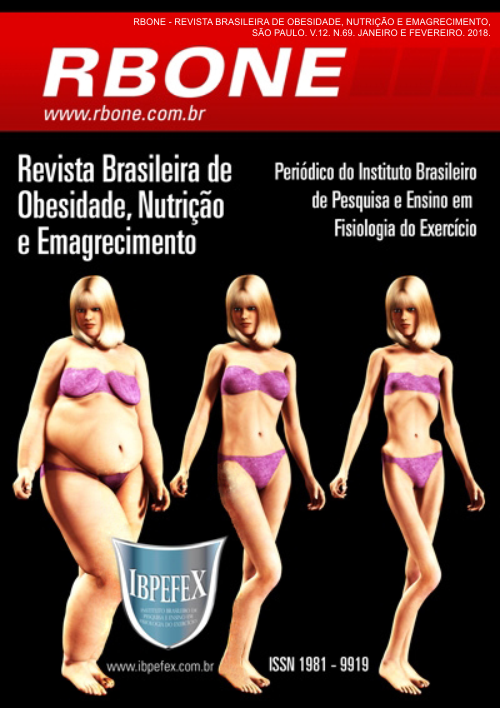Nutritional status and body image perception of Porto Alegre workers
Abstract
Background: Nutritional status and body image perception play an important role in programs of nutritional surveillance. Aim: to assess the relationship between nutritional status and perception of body image among workers of Porto Alegre, southern Brazil. Materials and Methods: In the current cross-sectional survey, 203 postmen were enrolled. Anthropometric variables included were weight, height, and waist and neck circumference. Body image perception was assessed by Figure Rating Scale developed by Stunkard (1983), adapted by Mash and Roche (1996). Results: Postmen were recruited between 2011 and 2013, in city of Porto Alegre. A mean age of 41.0 ± 11.3 years, and 74 (36.4%) individuals were classified as normal weight, 85 (41.9%), as overweight and 44 (21.7%), as obese. Regarding waist circumference, 115 (76.2%) men and 22 (42.3%) women were classified as adequate. In relation of neck circumference, 82.8% of men and 65.8% of women presented values greater than recommended. According perception of body image, just 60 (29.6%) subjects reported current body image consistent with required body image, and 143 (70.4%) subjects were dissatisfied with their current body image. Besides, postmen satisfied with their body image have significantly lower values of body weight, body mass index, and waist and neck circumference when compared to those non-satisfied. Conclusions: The present study showed a high prevalence of overweight and dissatisfied with body image. Association between status nutritional and body image indicated that the postmen had a good perception of their body image.
References
-Almeida, E. B.; Xavier, G. N. A.; Carminatti, L. J.; Giustina, M. C. D. Gasto calórico nas atividades de trabalho e cotidianas, dos carteiros que utilizam bicicleta. Rev Bras Cineantropom Desempenho Humano. Vol. 37. Num. 6. p. 760-767. 2004.
-Almeida, G. A. N.; Loureiro, S. R.; Santos, J. E.A Imagem Corporal de mulheres morbidamente obesas avaliada através do desenho da figura humana. Psicologia: Reflexão e Crítica. Vol. 15. Num. 2. p. 283-292. 2002.
-Ben-Noun, L.S. E.; Laor, A. Neck circumference as a simple screening measures for identifying overweight and obese patients. Obesity Research. Vol. 9. Num. 8. p. 470-477. 2001.
-Bosi, M. L. M.; Carvalho, R. J.; Costa, M. L. S.; Luiz, R. R.; Morgado, C. M. C. Autopercepção da imagem corporal entre estudantes de nutrição: um estudo no município do Rio de Janeiro. J Bras Psiquiatr. Vol. 55. Num. 2. p. 108-113. 2006.
-Damasceno, V. O.; Lima, J. R. P.; Viana, J. M.; Vianna, V. R. A.; Novaes, J. S. Tipo físico ideal e satisfação com a imagem corporal de praticantes de caminhada. Rev Bras Med Esporte. Vol. 11. Num. 3. p. 181-186. 2005.
-Damasceno, V. O.; Vianna, V. R. A.; Vianna, J. M.; Lacio, M.; Lima, J. R. P.;Novaes, J. S. Imagem corporal e corpo ideal. Revista Brasileira Ciência e Movimento. Vol. 14. Num. 1. p. 87-96. 2006.
-Kakeshita, I. S.; Almeida, S. S. Relação entre índice de massa corporal e a percepção da auto imagem em universitários. Rev Saúde Pública. Vol. 40. Num. 3. p. 497-504. 2006.
-Kelishadi, R. Childhood overweight, obesity, and the metabolic syndrome in developing countries. Epidemiologic reviews. Vol. 29. p. 62-76. 2007.
-Marsh, H. W.; Roche, L. Predicting self-esteem from perceptions of actual and ideal ratings of body fatness: is there only one ideal "supermodel". Research Quartely for Exercise and Sport. Vol. 67. Num. 1. p. 13-23. 1996.
-Martins, C. R.; Peregrini, A.; Matheus, S. C.; Petroski, E. L. Insatisfação com a imagem corporal e relação com estado nutricional, adiposidade corporal e sintomas de anorexia e bulimia em adolescentes. Rev Psiquiatr. Vol. 32. Num. 1. p. 19-23. 2010.
-Martins, M. V.; Leite, I. C. G. Aspectos nutricionais, antropometria e ingestão hídrica de trabalhadores metalúrgicos. Revista Brasileira Medicina Trabalho. Vol. 8. Num. 2. p. 82-88. 2010.
-Ministério da Saúde. Pesquisa de Orçamentos Familiares -Antropometria e Estado Nutricional de crianças, adolescentes e adultos no Brasil 2008 -2009. IBGE. 2010:1-130.
-Myers, A.; Rosen, J. C. Obesity stigmatization and coping: relation to mental health symptoms, body image, and self-esteem. International journal of obesity and related metabolic disorders: journal of the International Association for the Study of Obesity. Vol. 23. Num. 3. p. 221-230. 1999.
-Pereira, E. F.; Teixeira. CS.; Borgatto, A. F.; Daronco, L. S. E. Relação entre diferentes indicadores antropométricos e a percepção da imagem corporal em idosas ativas. Rev Psiq Clín. Vol. 36. Num. 2. p. 54-60. 2008.
-Scatolin,H. G. A imagem do corpo: as energias construtivas da psique. São Paulo, 2012.
-Stunkard, A. J.; Sörensen, T.; Schulsinger, F. Use of adaptation registry for the study of obesity and thinness. The Genetics of Neurological and Psychiatric Disorders. p. 115-120. 1983.
-Tribess, S.; Virtuoso, Jr,J. S.; Petroski, E. L. Estado nutricional e percepção da imagem corporal de mulheres idosas residentes no nordeste do Brasil. Ciência & Saúde Coletiva. Vol. 15. Num. 1. p. 31-38. 2010.
-World Health Organization (WHO). Physical Status: the use and interpretation of anthropometry -Report of a WHO Expert Committee -Geneva: World Health Organization. 1995.
-World Health Organization -WHO. Obesity: preventing and managing the global epidemic [report of a WHO Consultation on Obesity]. Geneva. 1997.
Authors who publish in this journal agree to the following terms:
- Authors retain the copyright and grant the journal the right of first publication, with work simultaneously licensed under the Creative Commons Attribution License BY-NC which allows the sharing of the work with acknowledgment of the authorship of the work and initial publication in this journal.
- Authors are authorized to enter into additional contracts separately for non-exclusive distribution of the version of the work published in this journal (eg, publishing in institutional repository or book chapter), with acknowledgment of authorship and initial publication in this journal.
- Authors are allowed and encouraged to post and distribute their work online (eg, in institutional repositories or on their personal page) at any point before or during the editorial process, as this can bring about productive change as well as increase impact and impact. citation of published work (See The Effect of Free Access).






